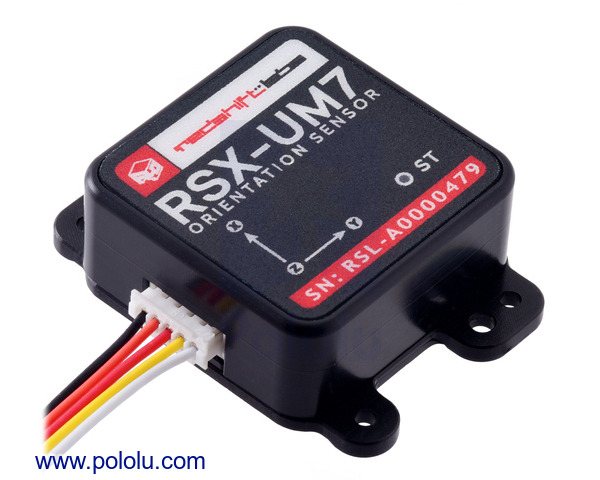

This is a merged information page for Item #2764.
View normal product page.
Pololu item #:
2764
Brand:
Redshift Labs

The UM7 orientation sensor from Redshift Labs is an Attitude and Heading Reference System (AHRS) that contains a three-axis accelerometer, rate gyro, and magnetometer. It combines this data using an Extended Kalman Filter to produce attitude and heading estimates.
Alternatives available with variations in these parameter(s): case/enclosure? Select variant…
 Compare all products in Accelerometers, Gyros, & Compasses or
Compare all products in Accelerometers, Gyros, & Compasses or  MEMS Sensors.
MEMS Sensors.
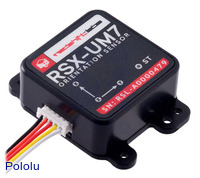 |
UM7 orientation sensor. |
|---|
 |
UM7 orientation sensor, bottom view showing option expansion headers and mounting holes. |
|---|
 |
UM7 orientation sensor with included cable and U.S. quarter for size reference. |
|---|
 |
UM7 orientation sensor with bracket plate removed. |
|---|
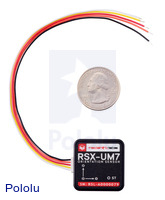 |
UM7 orientation sensor (with bracket plate removed) with included cable and U.S. quarter for size reference. |
|---|
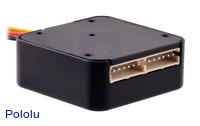 |
UM7 orientation sensor with bracket plate removed, bottom view showing option expansion headers and mounting holes. |
|---|
 |
Cable included with the UM7 and UM7-LT orientation sensors. |
|---|
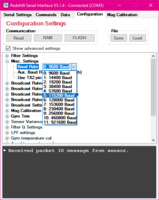 |
Redshift Serial Interface. |
|---|
 |
Graph of gyro readings displayed by the Redshift Serial Interface connected to a UM7 orientation sensor. |
|---|
The UM7 orientation sensor is a third-generation Attitude and Heading Reference System (AHRS) from Redshift Labs that produces attitude and heading estimates from triaxial accelerometer, rate gyro, and magnetometer data. Unlike a typical inertial measurement unit (IMU), which only provides raw sensor readings, the UM7 features an onboard microcontroller that combines sensor data using a sophisticated Extended Kalman Filter (EKF) to generate orientation estimates 500 times a second.
Two versions of the UM7 are available: the UM7 orientation sensor, which includes an enclosure, and the UM7-LT, which does not. The two versions are functionally equivalent, and both include a cable.
|
|
The UM7 features a number of improvements over its predecessor, the UM6, including higher gyro bias stability and lower noise, a new communication architecture for improved flexibility, optional NMEA packet transmission, UTC time-synchronization with external GPS, and support for third-order temperature compensation on all sensors. It takes advantage of newer MEMS (micro-electro-mechanical systems) technology that allows it to offer better performance at a lower price.
Connections for power and TTL serial communication can be made to the UM7 through a polarized five-pin male connector on one side, which mates with an included cable assembly. A pair of six-pin expansion headers on the other side of the board provide additional connectivity options, including an alternative SPI interface and a secondary serial interface that can be connected to an external GPS module (like our LS20031 GPS receiver). Additional cable assemblies for the expansion headers are not included.
You can use a general-purpose USB-to-TTL-serial adapter, such as our CP2104 carrier or USB AVR programmer, to connect the UM7 to your computer. You can then use the Redshift Serial Interface (available in the “Resources” tab) to configure the sensor, and view and log data in real-time.
Updated UM7 enclosure: In September 2021, the UM7 enclosure design changed to lose the tabs with the mounting holes and move the mounting holes to the bottom of the case as show in this file (15k dwg). As of February 2022, UM7 units ship with a removable bracket plate that adds mounting holes in the same locations as the original enclosure design.
|
|
|
Product #2764 is the UM7 orientation sensor with an enclosure. The bottom side of the enclosure features five threaded mounting holes for M1.4 screws (not included). We recommend screwing no more than 3 mm (0.12″) into the mounting holes.
We carry several inertial measurement and orientation sensors. The table below compares their capabilities:
| Product Name | Sensors | Estimation | Other | ||||||
|---|---|---|---|---|---|---|---|---|---|
| Gyros (3x) | Accels (3x) | Mag (3x) | Altitude | Roll | Pitch | Yaw | Quaternion | Enclosure | |
| Pololu MinIMU-9 v6 |  |
 |
 |
||||||
| Pololu AltIMU-10 v6 |  |
 |
 |
 |
|||||
| Redshift Labs UM7-LT Orientation Sensor |  |
 |
 |
 |
 |
 |
 |
||
| Redshift Labs UM7 Orientation Sensor |  |
 |
 |
 |
 |
 |
 |
 |
|
 |
Redshift Serial Interface. |
|---|
 |
Graph of gyro readings displayed by the Redshift Serial Interface connected to a UM7 orientation sensor. |
|---|
The UM7-LT and UM7 orientation sensors were originally developed by CH Robotics, and Redshift Labs is now manufacturing and supporting them. Some components have been updated on these versions of the sensors, and the UM7-LT now ships with a conformal coating, but the sensors should otherwise be functionally identical to the previous versions.
| Size: | 1.10″ × 1.12″ × 0.44″ |
|---|---|
| Weight: | 8.3 g1 |
| Interface: | TTL serial, SPI |
|---|---|
| Minimum operating voltage: | 4 V |
| Maximum operating voltage: | 5.5 V |
| Maximum logic voltage: | 3.3 V2 |
| Axes: | pitch (x), roll (y), and yaw (z) |
| Measurement range: |
±2000°/s (gyro) ±8 g (accelerometer) ±12 gauss (magnetometer) |
| Supply current: | 50 mA |
| Case/enclosure?: | Y |
Datasheet for the Redshift Labs UM7 orientation sensor, revision 1.8 (released July 30, 2018).
Version 3.1.5. The Serial Interface makes it easy to plot data in real-time, log data, and set configuration registers on the UM7 product line. Any Redshift Labs / CH Robotics device that communicates using the CHR binary serial protocol can be controlled using the Serial Interface.
|
|
This DWG drawing shows the locations of the mounting holes on the bottom side of the UM7 enclosure. The holes are threaded for M1.4 screws, and we recommend screwing no more than 3 mm (0.12″) into the mounting holes.
Note: this drawing is only applicable to UM7 units (product #2764) with the updated enclosure design that began shipping in September 2021.
No FAQs available.
The UM7-LT and UM7 orientation sensors, originally developed by CH Robotics, are now being manufactured and supported by Redshift Labs. The updated...